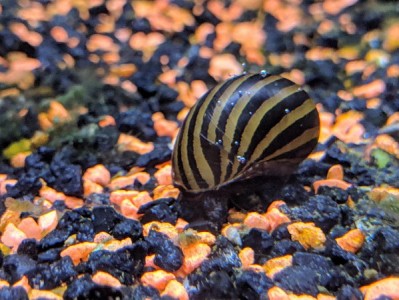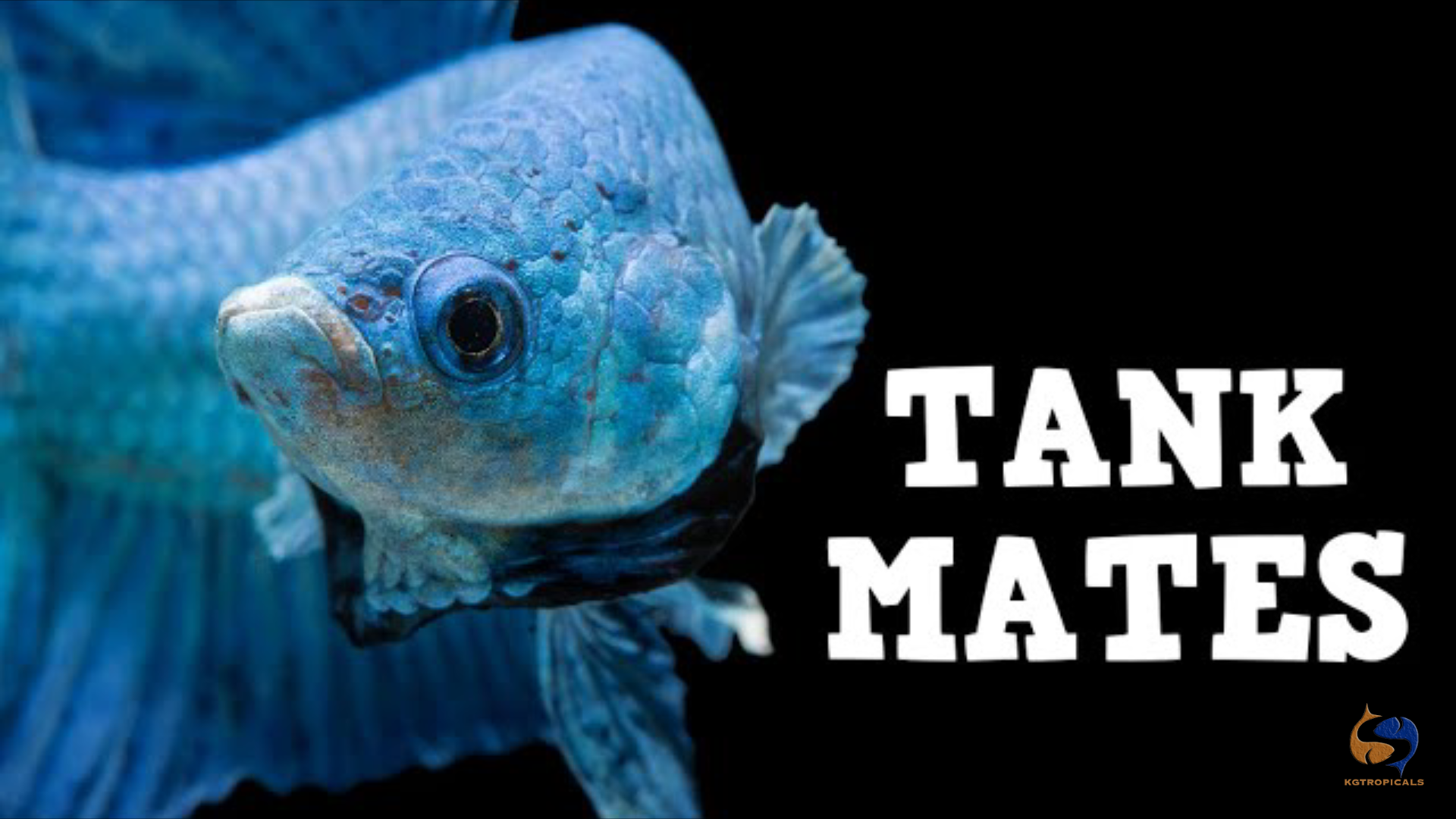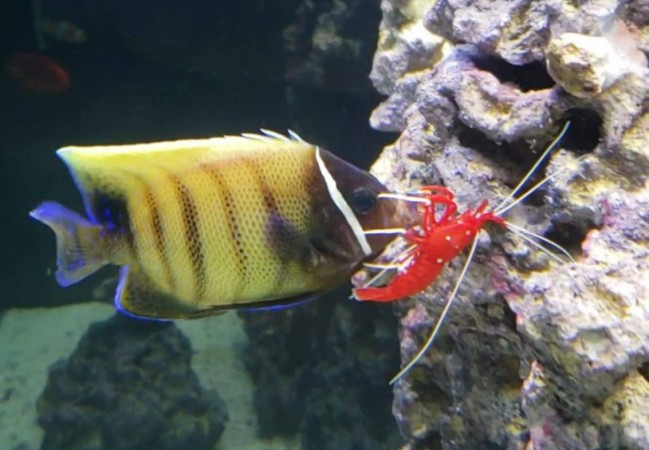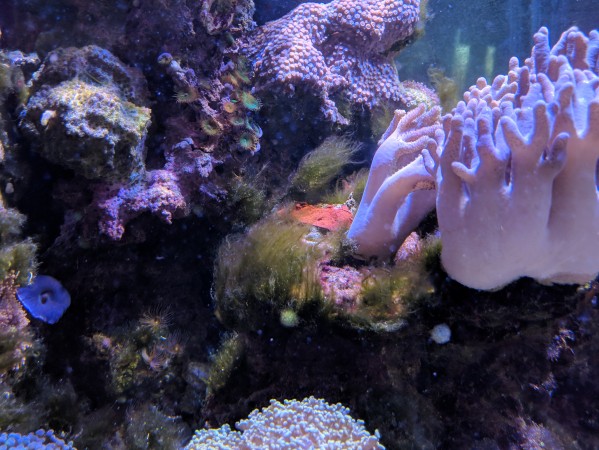- Name:
Nerita Snail, Zebra
- Family: Neritidae
- Species: Snail
- Scientific Name: Neritina sp


General info about Nerita Snail, Zebra
Zebra Nerite Snails are the most popular species of freshwater Nerite snail in the aquarium hobby. Nerite snails are very low-maintenance and rather hardy, making them perfect for beginning aquarium enthusiasts. They can be identified by their distinct black and gold stripes running from a point at its shells tail and named for their distinct black and gold striping pattern. These snails possess a simple yet elegant beauty that draws all eyes directly to them in any aquarium set-up. However, there is much more to these snails than looks, as they are voracious algae-eaters!
They work hard to clean algae off of glass, plants, and decorations, they eat hair algae, and they keep your substrate clean and the correct color. In fact, nerite snails are widely believed to be the single best snail in the aquarium hobby for obliterating algae off of glass, rocks, live plants, driftwood, and other types of decorations.
In optimal water conditions, the average nerite snails can live for up to 2 years or even longer. In many cases zebra snails can die within a week or so of being added to a new tank, this is mainly due to the stress caused from the transportation or more commonly the water conditions/parameters of the actual tank it's being added to. Testing the water the snail came in against the tank water before adding the snail is always a good idea so you can see the pH, Nitrate and Ammonia level differences and determine based on the results if the snail will survive or not (assuming the results/water conditions are similar). If the snail does not survive then be sure to remove the dead snail as quickly as you can as it can cause the Ammonia levels to suddenly rise which is not good for the tank and other inhabitants.
Zebra snails are fairly small in size and rarely grow above 1 inch in length, with the average size being around ½ inch in length. Zebra Nerite Snails are known as a species of 'tidal snail'. The name comes from the ability of the snail to live out of the water for prolonged periods of time. Unfortunately, it is not uncommon for Nerite Snails to escape the aquarium. These snails are quite resilient in the sense that they love to be in the water, but they also like to go out of the water. That being said, the aquarium you have them in should ideally have a lid to prevent escape. They are fairly easy to find and can be picked up and placed back into the aquarium. It is encouraged to keep a daily eye on snails.
Nerite Snails are completely peaceful, and therefore safe to keep with any fish, shrimp, live plants, or other snails. Zebra Nerite Snails can be kept with other non-aggressive shrimp, fish and snail species. Zebra Nerite Snails will consume debris and surface algae from the glass and substrate surface. They are a community player and an excellent addition to any aquariumThese snails are fairly friendly and do well in community tanks, especially with other animals such as non-aggressive snails, non-violent fish, and shrimp too
While zebra nerite snails are fairly resilient creatures, they do still require some pretty specific water parameters in order to stay alive and healthy. These snails do the best in water temperature that is anywhere between 70 and 80 degrees Fahrenheit. The optimal temperature for these creatures is around 75 degrees Fahrenheit. These snails can also survive in unheated tanks that are quite cold as well. The pH level or the acidity of the water is another important factor. These snails do best in water that has a pH level anywhere between 7 and 8. Any lower than a pH level of 7 will cause damage to the snails and may even kill them. In other words, they do best in waters that are slightly basic in nature.
Zebra Nerite Snails are excellent at consuming algae and organics. However, in large numbers, they will require extra food. For this reason, it is wise to stock no more than one snail for every 5 gallons of aquarium water. Generally speaking, these snails can live in both salt and freshwater. However, the optimal water type is brackish water, which is water that is fresh and borders slightly on salt water.
Zebra nerite snails prefer water that is hard as opposed to soft, meaning that they like a fair amount of dissolved minerals in the water. This is because certain minerals present in the water help these snails to develop a strong shell. Ideally, the water hardness should be between 6 and 12 dkH, with the optimal level being around 9 dkH. Zebra Nerite Snails prefer harder water as it aids in shell development. Limestone chips placed in the filter can be used to harden the water.
They don’t require very much space, but space is always a bonus. Also, these things like to be in aquariums that are planted and have lots of greenery in them. On a side note, zebra nerite snails have a very hard time turning over when they are upside down. Never drop them into the tank and let them float to the bottom. A turned over nerite snail will probably not be able to right itself and will most likely die due to an inability to move.
Nerita Snail, Zebra Diet & Nutrition
One of the best parts of having zebra nerite snails, especially when you have a few of them, is that they love to eat algae. In other words, these things make excellent tank cleaners that keep the water in your aquarium free of algae. They are effective cleaners and will leave the glass and substrate very clean. This makes feeding them very easy because they love to eat algae and organic matter.
Zebra Nerite Snails sometimes need supplemental food if there is low organic matter and algae in the aquarium. Zebra Nerite Snails can simply be fed with algae wafer, commercial flake, and pellet food. Sometimes they will consume boiled vegetables(such as kale, zucchini, carrots, etc.).
They are not fussy eaters. The filter should be turned off during feeding to allow the food to float to the substrate where it is easily accessible for the Zebra Nerite Snails. After all, these are slow-moving snails that cannot chase their food around, even if it is dead organic matter.
Determining Sex of Nerita Snail, Zebra
They are not hermaphroditic snails, so they are made up of male and female snails.
Breeding & Spawning Nerita Snail, Zebra
As with other species of Nerite snails, Zebra Nerite Snails are near impossible to breed in freshwater. This makes them favorable when compared to other snail species that can overpopulate in the aquarium. They require brackish salty water to reproduce and grow up as well. Raising young in freshwater is impossible and raising them in brackish water is very difficult. It is also important to note Zebra Nerite Snails successfully raised in captivity have much shorter lifespans.
Successful breeding can happen in species only aquariums. Salinity should be raised to 1.007 and confirmed using a salinity refractometer. The temperature should be raised to 79°F (27°C) and substrate should be replaced with calcium-rich chips to support shell growth in newborn snails.
Another important tip is to have a group of 5 Nerite snails or more, as this makes it more likely that the group will contain both males and females. Once the snails are comfortable in their environment, they will lay eggs that will soon hatch into larvae without shells. The young snails will develop shells, and after some time may be placed in either a brackish water or freshwater aquarium.
Nerita Snail, Zebra Origin
Zebra Nerite snails hail from Africa - specifically Kenya, Mozambique, Somalia, South Africa, and Tanzania.
Caution with Nerita Snail, Zebra
Nitrite levels in your aquarium should be as close to 0 parts per million as possible, and the same goes for nitrate levels, as well as ammonia levels too. The only exception is that as long as you keep nitrate levels under 40 parts per million, your snails should be just fine. Zebra nerite snails are very sensitive to nitrites and ammonia, so those levels should definitely be kept to an absolute minimum.
Snails are very sensitive to copper, so watch out for copper if you use tap water in your tank. Avoid any food product, medication, or plant fertilizer that contains Copper of any form. Copper is toxic to invertebrates. Many commercial fish foods, medications, and plant fertilizers contain copper or more commonly copper sulfate. Always look at the ingredient list for any product going into the aquarium to ensure they are copper free.
Original Detail
| Name | Species | Family | Scientific Name | More Detail | Added by |
|---|---|---|---|---|---|
| Nerita Snail, Zebra | Snail | Neritidae | Neritina sp | Zebra Nerite Snails are the most popular species of freshwater Nerite snail in the aquarium hobby. Nerite snails are very low-maintenance and rather hardy, making them perfect for beginning aquarium enthusiasts. They can be identified by their distinct black and gold stripes running from a point at its shells tail and named for their distinct black and gold striping pattern. These snails possess a simple yet elegant beauty that draws all eyes directly to them in any aquarium set-up. However, there is much more to these snails than looks, as they are voracious algae-eaters! They work hard to clean algae off of glass, plants, and decorations, they eat hair algae, and they keep your substrate clean and the correct color. In fact, nerite snails are widely believed to be the single best snail in the aquarium hobby for obliterating algae off of glass, rocks, live plants, driftwood, and other types of decorations. In optimal water conditions, the average nerite snails can live for up to 2 years or even longer. In many cases zebra snails can die within a week or so of being added to a new tank, this is mainly due to the stress caused from the transportation or more commonly the water conditions/parameters of the actual tank it's being added to. Testing the water the snail came in against the tank water before adding the snail is always a good idea so you can see the pH, Nitrate and Ammonia level differences and determine based on the results if the snail will survive or not (assuming the results/water conditions are similar). If the snail does not survive then be sure to remove the dead snail as quickly as you can as it can cause the Ammonia levels to suddenly rise which is not good for the tank and other inhabitants. Zebra snails are fairly small in size and rarely grow above 1 inch in length, with the average size being around ½ inch in length. Zebra Nerite Snails are known as a species of 'tidal snail'. The name comes from the ability of the snail to live out of the water for prolonged periods of time. Unfortunately, it is not uncommon for Nerite Snails to escape the aquarium. These snails are quite resilient in the sense that they love to be in the water, but they also like to go out of the water. That being said, the aquarium you have them in should ideally have a lid to prevent escape. They are fairly easy to find and can be picked up and placed back into the aquarium. It is encouraged to keep a daily eye on snails. Nerite Snails are completely peaceful, and therefore safe to keep with any fish, shrimp, live plants, or other snails. Zebra Nerite Snails can be kept with other non-aggressive shrimp, fish and snail species. Zebra Nerite Snails will consume debris and surface algae from the glass and substrate surface. They are a community player and an excellent addition to any aquariumThese snails are fairly friendly and do well in community tanks, especially with other animals such as non-aggressive snails, non-violent fish, and shrimp too While zebra nerite snails are fairly resilient creatures, they do still require some pretty specific water parameters in order to stay alive and healthy. These snails do the best in water temperature that is anywhere between 70 and 80 degrees Fahrenheit. The optimal temperature for these creatures is around 75 degrees Fahrenheit. These snails can also survive in unheated tanks that are quite cold as well. The pH level or the acidity of the water is another important factor. These snails do best in water that has a pH level anywhere between 7 and 8. Any lower than a pH level of 7 will cause damage to the snails and may even kill them. In other words, they do best in waters that are slightly basic in nature. Zebra Nerite Snails are excellent at consuming algae and organics. However, in large numbers, they will require extra food. For this reason, it is wise to stock no more than one snail for every 5 gallons of aquarium water. Generally speaking, these snails can live in both salt and freshwater. However, the optimal water type is brackish water, which is water that is fresh and borders slightly on salt water. Zebra nerite snails prefer water that is hard as opposed to soft, meaning that they like a fair amount of dissolved minerals in the water. This is because certain minerals present in the water help these snails to develop a strong shell. Ideally, the water hardness should be between 6 and 12 dkH, with the optimal level being around 9 dkH. Zebra Nerite Snails prefer harder water as it aids in shell development. Limestone chips placed in the filter can be used to harden the water. They don’t require very much space, but space is always a bonus. Also, these things like to be in aquariums that are planted and have lots of greenery in them. On a side note, zebra nerite snails have a very hard time turning over when they are upside down. Never drop them into the tank and let them float to the bottom. A turned over nerite snail will probably not be able to right itself and will most likely die due to an inability to move. |
PalaciosAn |
Changed by users
| Submitted Date | Submitted By | Status | Action |
|---|





